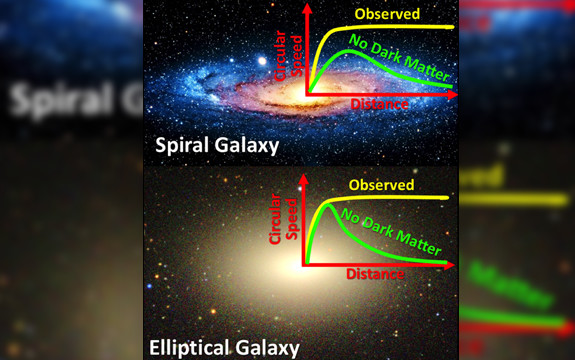The Dark Matter ‘conspiracy’

In Summary
Surprising gravitational similarities between spiral and elliptical galaxies have been discovered by an international team, including astronomers from Swinburne University of Technology, implying the influence of hidden forces.
In the first such survey to capture large numbers of these galaxies, researchers have mapped out the motions of stars in the outer parts of elliptical galaxies using the world’s largest optical telescope at W M Keck Observatory in Hawaii.
“By combining Keck telescope time from Swinburne and the University of California, we were able to investigate a larger number of galaxies which allowed us to make this important discovery,” Swinburne’s Professor Duncan Forbes said.
The team, led by Michele Cappellari from the University of Oxford, used the powerful DEIMOS (DEep Imaging and Multi-Object Spectrograph) to conduct a major survey of nearby galaxies called SLUGGS, which mapped out the speeds of their stars.
The scientists used Newton's law of gravity to translate these speed measurements into the amounts of matter distributed within the galaxies.
One of the most surprising scientific discoveries of the 20th century was that spiral galaxies, such as our own Milky Way, rotate much faster than expected, powered by an extra gravitational force of invisible ‘dark matter’.
Since this discovery 40 years ago, we have learned this mysterious substance, which is probably an exotic elementary particle, makes up about 85 per cent of the mass in the known Universe, leaving only 15 per cent to be the ordinary stuff encountered in our everyday lives.
Dark matter is central to our understanding of how galaxies form and evolve and is ultimately one of the reasons for the existence of life on Earth – yet we know almost nothing about it.
“One of the surprising findings of this study was that spiral galaxies maintain a remarkably constant rotation speed throughout their disks,” Dr Cappellari said. “This means stars and dark matter conspire to redistribute themselves to produce this effect, with stars dominating in the inner regions of the galaxies, and a gradual shift in the outer regions to dark matter dominance.”
But the ‘conspiracy’ does not come out naturally from the models, and some fine-tuning is required to explain the observations. For this reason, some astronomers have suggested that, rather than being due to dark matter, it may be due to Newton's law of gravity becoming progressively less accurate at large distances.
Remarkably, decades after it was proposed, this alternative theory (without dark matter) still could not be conclusively ruled out.
Spiral galaxies constitute less than half of the stellar mass in the Universe, which is dominated by elliptical and lenticular galaxies. These have puffier configurations of stars and lack the flat disks of gas that spiral galaxies have. Until now it has been technically difficult to measure the masses of elliptical galaxies and to find out how much dark matter they have, and how this is distributed.
Because elliptical galaxies have different shapes and formation histories than spiral galaxies, the newly discovered conspiracy is even more profound and will lead experts in dark matter and galaxy formation to think carefully about what has happened in the ‘dark sector’ of the Universe.
The study is published in The Astrophysical Journal Letters.

